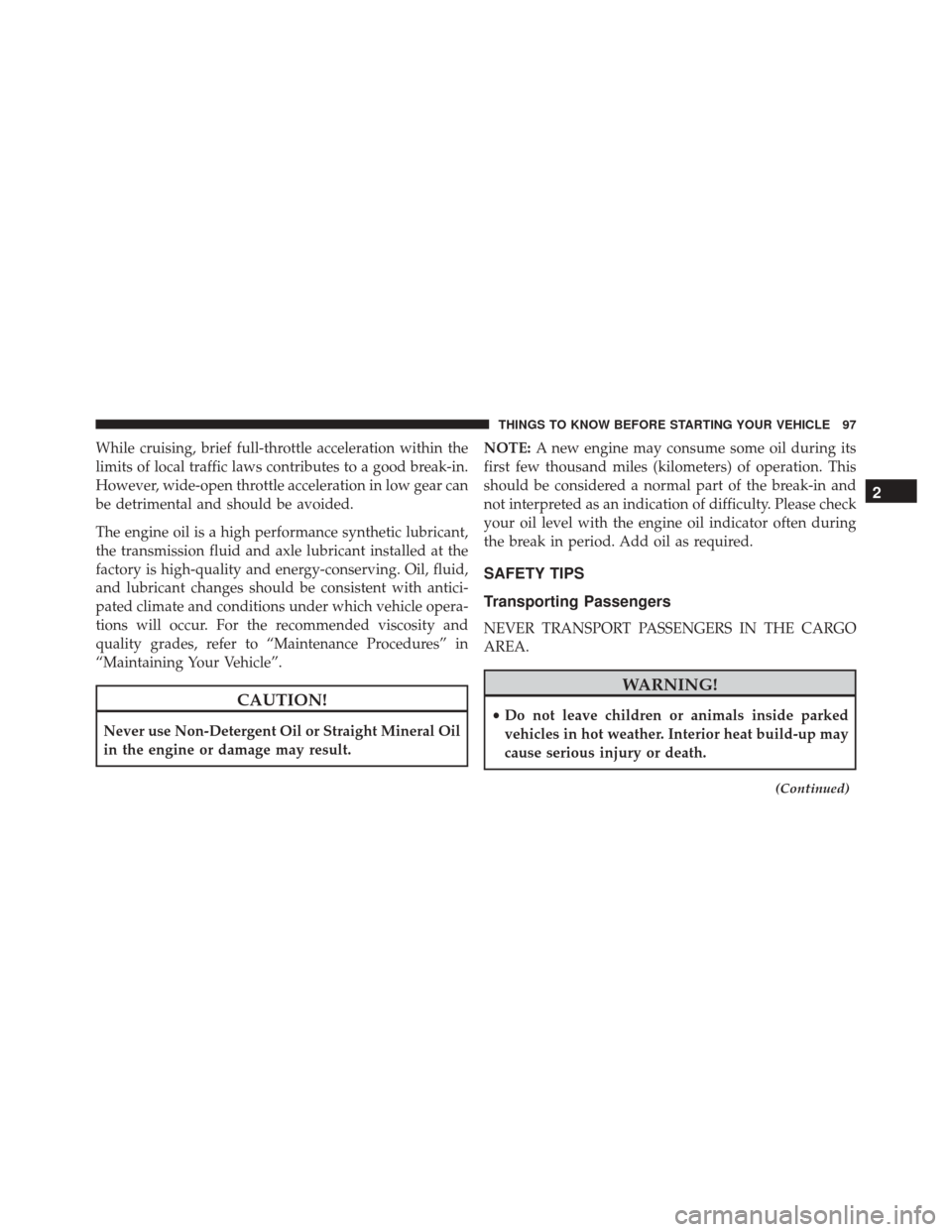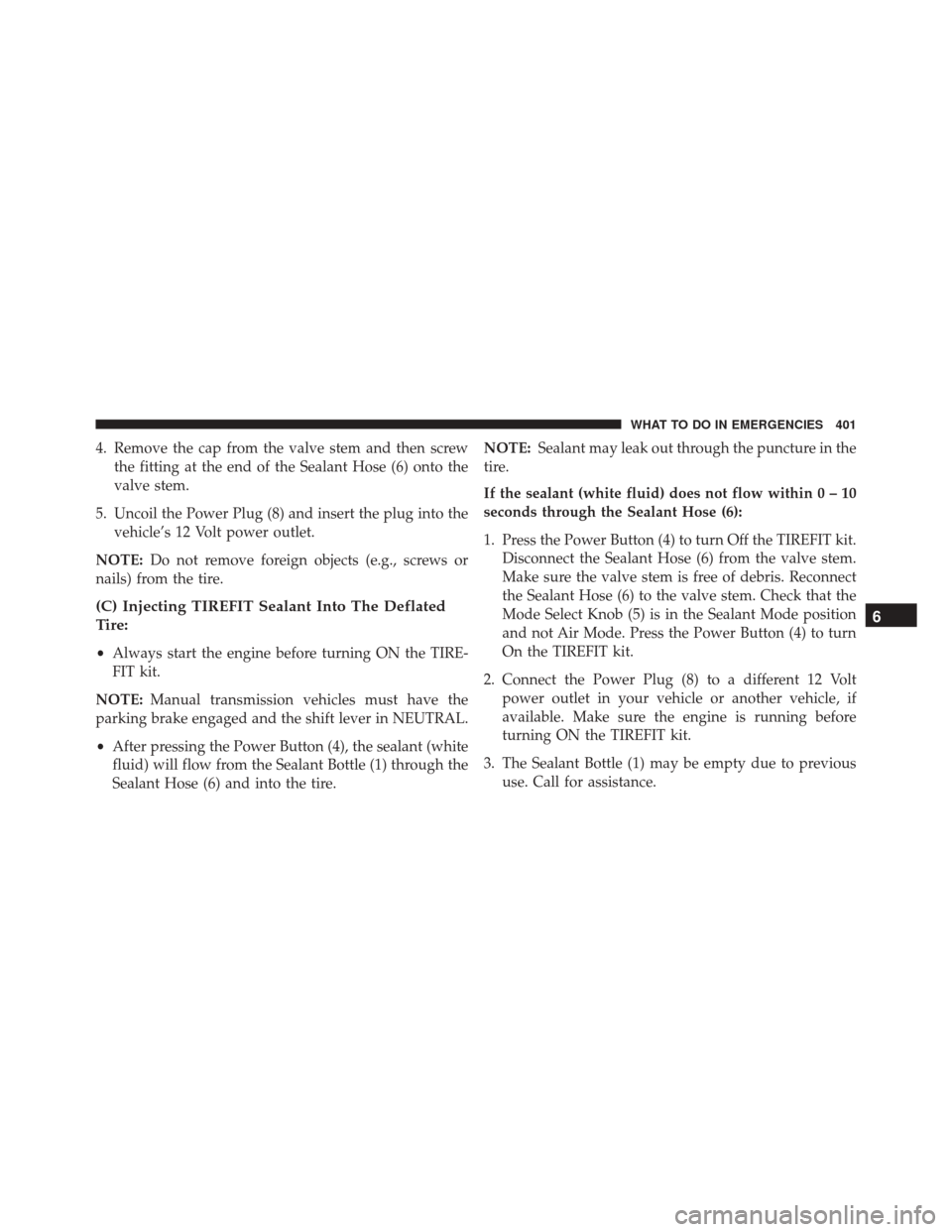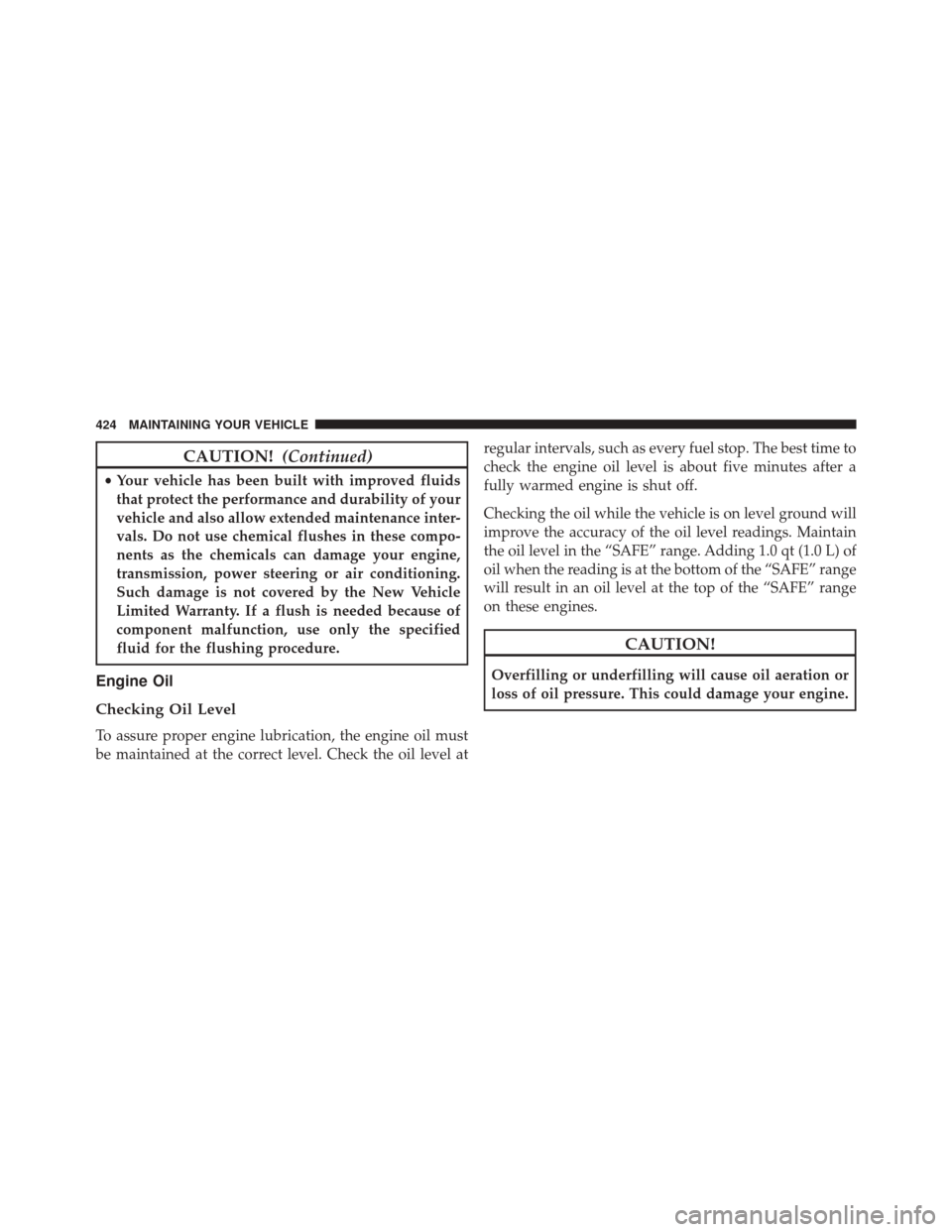Page 98 of 529

While cruising, brief full-throttle acceleration within the
limits of local traffic laws contributes to a good break-in.
However, wide-open throttle acceleration in low gear can
be detrimental and should be avoided.
The engine oil is a high performance synthetic lubricant,
the transmission fluid and axle lubricant installed at the
factory is high-quality and energy-conserving. Oil, fluid,
and lubricant changes should be consistent with antici-
pated climate and conditions under which vehicle opera-
tions will occur. For the recommended viscosity and
quality grades, refer to “Maintenance Procedures” in
“Maintaining Your Vehicle”.
CAUTION!
Never use Non-Detergent Oil or Straight Mineral Oil
in the engine or damage may result.NOTE:
A new engine may consume some oil during its
first few thousand miles (kilometers) of operation. This
should be considered a normal part of the break-in and
not interpreted as an indication of difficulty. Please check
your oil level with the engine oil indicator often during
the break in period. Add oil as required.
SAFETY TIPS
Transporting Passengers
NEVER TRANSPORT PASSENGERS IN THE CARGO
AREA.
WARNING!
• Do not leave children or animals inside parked
vehicles in hot weather. Interior heat build-up may
cause serious injury or death.
(Continued)
2
THINGS TO KNOW BEFORE STARTING YOUR VEHICLE 97
Page 293 of 529

�AUTOSTICK® ........................ .318
▫ Steering Wheel Mounted Paddle Shifters Or
Console Mounted Shifter ................318
� SPORT MODE ........................ .321
� LAUNCH MODE — IF EQUIPPED ..........322
� DRIVING ON SLIPPERY SURFACES .........327
▫ Acceleration ........................ .327
▫ Traction ........................... .327
� DRIVING THROUGH WATER .............328
▫ Flowing/Rising Water ..................328
� POWER STEERING .....................330
▫ Power Steering Fluid Check ..............331
� FUEL SAVER TECHNOLOGY —
IF EQUIPPED ......................... .332�
PARKING BRAKE ..................... .332
▫ Manual Transmission — If Equipped ........333
▫ Automatic Transmission — If Equipped ......334
� BRAKE SYSTEM ...................... .336
▫ Anti-Lock Brake System (ABS) ............336
� ELECTRONIC BRAKE CONTROL SYSTEM . . . .339
▫ Anti-Lock Brake System (ABS) ............339
▫ Traction Control System (TCS) ............340
▫ Brake Assist System (BAS) ...............340
▫ Hill Start Assist (HSA) .................341
▫ Electronic Stability Control (ESC) ..........343
▫ ESC Activation/Malfunction Indicator Light And
ESC OFF Indicator Light ................346
292 STARTING AND OPERATING
Page 306 of 529
CAUTION!
•Never drive with your foot resting on the clutch
pedal, or try to hold the vehicle on a hill with the
clutch pedal partially engaged, as this will cause
abnormal wear on the clutch. Refer to “Electronic
Brake Control System/Hill Start Assist” in “Start-
ing And Operating” for further information.
• Failure to press the clutch pedal fully to the floor
may cause increased shift efforts, and may result in
damage to the clutch and transmission.
• Do not rest your hand on the shift lever while
driving, as this may result in transmission synchro-
nizer damage.
• Do not attempt to shift the transmission if the rear
wheels are spinning due to loss of traction. Dam-
age to the transmission may occur. NOTE:
During cold weather, you may experience in-
creased effort in shifting until the transmission fluid
warms up. This is normal.
Manual Shifter
5
STARTING AND OPERATING 305
Page 333 of 529

WARNING!
Fluid level should be checked on a level surface and
with the engine off to prevent injury from moving
parts and to ensure accurate fluid level reading. Do
not overfill. Use only manufacturer’s recommended
power steering fluid.
If necessary, add fluid to restore to the proper indicated
level. With a clean cloth, wipe any spilled fluid from all
surfaces. Refer to “Fluids, Lubricants, and Genuine
Parts” in “Maintaining Your Vehicle” for further informa-
tion.
FUEL SAVER TECHNOLOGY — IF EQUIPPED
This feature offers improved fuel economy by shutting
off four of the engine’s eight cylinders during light load
and cruise conditions. The system is automatic with no
driver inputs or additional driving skills required. NOTE:
This system may take some time to return to full
functionality after a battery disconnect.
PARKING BRAKE
Before leaving the vehicle, make sure that the parking
brake is fully applied and place the shift lever in the
PARK or REVERSE (manual transmission only) position.
When the parking brake is applied and the ignition
switch is in the ON position (RUN position with Keyless
Enter-N-Go™), the “Brake Warning Light” in the instru-
ment cluster will illuminate.
NOTE:
• When the parking brake is applied and the transmis-
sion is placed in gear, the “Brake Warning Light” will
flash. If vehicle speed is detected, a chime will sound
to alert the driver. Fully release the parking brake
before attempting to move the vehicle.
332 STARTING AND OPERATING
Page 402 of 529

4. Remove the cap from the valve stem and then screwthe fitting at the end of the Sealant Hose (6) onto the
valve stem.
5. Uncoil the Power Plug (8) and insert the plug into the vehicle’s 12 Volt power outlet.
NOTE: Do not remove foreign objects (e.g., screws or
nails) from the tire.
(C) Injecting TIREFIT Sealant Into The Deflated
Tire:
• Always start the engine before turning ON the TIRE-
FIT kit.
NOTE: Manual transmission vehicles must have the
parking brake engaged and the shift lever in NEUTRAL.
• After pressing the Power Button (4), the sealant (white
fluid) will flow from the Sealant Bottle (1) through the
Sealant Hose (6) and into the tire. NOTE:
Sealant may leak out through the puncture in the
tire.
If the sealant (white fluid) does not flow within0–10
seconds through the Sealant Hose (6):
1. Press the Power Button (4) to turn Off the TIREFIT kit. Disconnect the Sealant Hose (6) from the valve stem.
Make sure the valve stem is free of debris. Reconnect
the Sealant Hose (6) to the valve stem. Check that the
Mode Select Knob (5) is in the Sealant Mode position
and not Air Mode. Press the Power Button (4) to turn
On the TIREFIT kit.
2. Connect the Power Plug (8) to a different 12 Volt power outlet in your vehicle or another vehicle, if
available. Make sure the engine is running before
turning ON the TIREFIT kit.
3. The Sealant Bottle (1) may be empty due to previous use. Call for assistance.
6
WHAT TO DO IN EMERGENCIES 401
Page 418 of 529
MAINTAINING YOUR VEHICLE
CONTENTS
�ENGINE COMPARTMENT —
6.4L (392 HEMI) ...................... .419
� ONBOARD DIAGNOSTIC SYSTEM — OBD II . .420
▫ Loose Fuel Filler Cap ..................420
� EMISSIONS INSPECTION AND MAINTENANCE
PROGRAMS ......................... .421
� REPLACEMENT PARTS ..................422
� DEALER SERVICE ..................... .423
� MAINTENANCE PROCEDURES ...........423
▫ Engine Oil ......................... .424
▫ Engine Oil Filter ..................... .426▫
Engine Air Cleaner Filter ................426
▫ Maintenance-Free Battery ...............427
▫ Air Conditioner Maintenance .............429
▫ Body Lubrication .....................433
▫ Windshield Wiper Blades ...............433
▫ Adding Washer Fluid ..................434
▫ Exhaust System ..................... .434
▫ Cooling System ..................... .437
▫ Brake System ....................... .443
▫
Clutch Hydraulic System (Manual Transmission) —
If Equipped ......................... .445
7
Page 419 of 529

▫Manual Transmission — If Equipped .......446
▫ Automatic Transmission — If Equipped .....446
▫ Rear Axle .......................... .448
▫ Appearance Care And Protection From
Corrosion .......................... .449
� FUSES ............................. .455
▫ Integrated Power Module ...............455
▫ Rear Power Distribution Center ...........459
� VEHICLE STORAGE ....................464
� REPLACEMENT BULBS .................464
� BULB REPLACEMENT ..................465
▫ Low Beam Headlamp, High Beam Headlamp,
Park/Turn Lamp — Models with Halogen
Headlamps — If Equipped ...............465 ▫
Low Beam Headlamp, High Beam Headlamp, and
Park/Turn Lamp — Models with High Intensity
Discharge (HID) Headlamps — If Equipped . . .465
▫ Front/Rear Side Marker Lamp ............466
▫ Tail/Turn And Stop Lamp ...............467
▫ Center Tail/Backup Lamp ...............469
▫ Center High-Mounted Stop Lamp (CHMSL) . .469
▫ License Lamp ....................... .469
� FLUID CAPACITIES ....................471
� FLUIDS, LUBRICANTS AND GENUINE
PARTS ............................. .472
▫ Engine ............................ .472
▫ Chassis ........................... .473
418 MAINTAINING YOUR VEHICLE
Page 425 of 529

CAUTION!(Continued)
•Your vehicle has been built with improved fluids
that protect the performance and durability of your
vehicle and also allow extended maintenance inter-
vals. Do not use chemical flushes in these compo-
nents as the chemicals can damage your engine,
transmission, power steering or air conditioning.
Such damage is not covered by the New Vehicle
Limited Warranty. If a flush is needed because of
component malfunction, use only the specified
fluid for the flushing procedure.
Engine Oil
Checking Oil Level
To assure proper engine lubrication, the engine oil must
be maintained at the correct level. Check the oil level at regular intervals, such as every fuel stop. The best time to
check the engine oil level is about five minutes after a
fully warmed engine is shut off.
Checking the oil while the vehicle is on level ground will
improve the accuracy of the oil level readings. Maintain
the oil level in the “SAFE” range. Adding 1.0 qt (1.0 L) of
oil when the reading is at the bottom of the “SAFE” range
will result in an oil level at the top of the “SAFE” range
on these engines.
CAUTION!
Overfilling or underfilling will cause oil aeration or
loss of oil pressure. This could damage your engine.
424 MAINTAINING YOUR VEHICLE